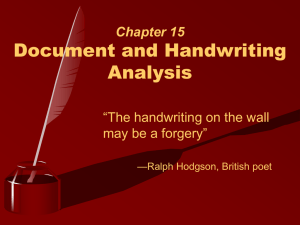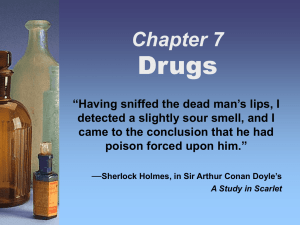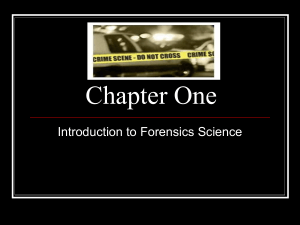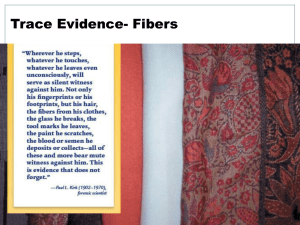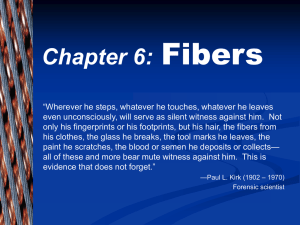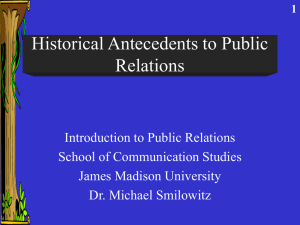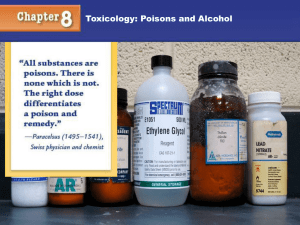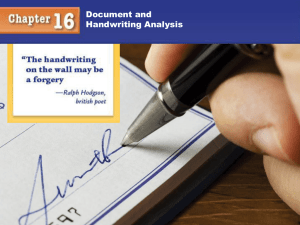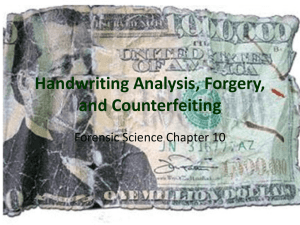Chapter 15
advertisement
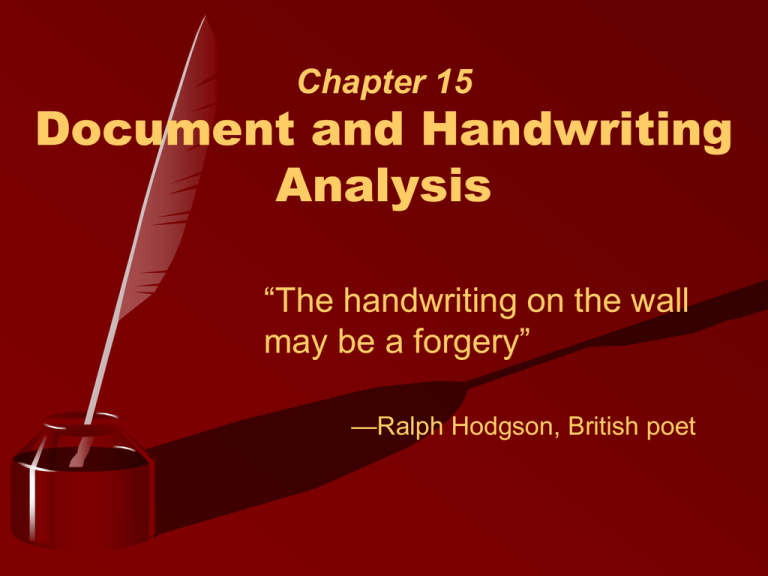
Chapter 15 Document and Handwriting Analysis “The handwriting on the wall may be a forgery” —Ralph Hodgson, British poet Document Analysis Students will learn: That an expert analyst can individualize handwriting to a particular person. What types of evidence are submitted to the document analyst. Three types of forgery. How to characterize different types of paper. Chapter 15 Kendall/Hunt Publishing Company 1 Document Analysis Students will be able to: Analyze handwriting using 12 points of analysis. Detect deliberately disguised handwriting. Detect erasures and develop impression writing. Design an experiment using paper chromatography to determine which pen altered a note. List safeguards against the counterfeiting of U.S. currency. Chapter 15 Kendall/Hunt Publishing Company 2 Questioned Documents Involves the examination of handwriting, ink, paper, etc. to ascertain source or authenticity Examples include letters, checks, licenses, contracts, wills, passports Investigations include: verification, authentication, characterizing papers, pigments, and inks Chapter 15 Kendall/Hunt Publishing Company 3 Related Fields Historical Dating—the verification of age and value of a document or object Fraud Investigation—focuses on the money trail and criminal intent Paper and Ink Specialists—date, type, source, and/or catalogue various types of paper, watermarks, ink, printing/copy/fax machines, computer cartridges Forgery Specialists—analyze altered, obliterated, changed, or doctored documents and photos Typewriting Analysts—determine origin, make, and models Computer Crime Investigators—investigate cybercrime Kendall/Hunt Publishing Company Chapter 15 4 Document Examination Forensic Document Examination —involves the analysis and comparison of questioned documents with known material in order to identify whenever possible, the author or origin of the questioned document. Over the years, the knowledge of how to write becomes subconscious and individualized. Because it is a subconscious activity, it is difficult to disguise or fake. Given enough and recent exemplars (sample for comparison), handwriting can be presented as individual evidence in court. Chapter 15 Kendall/Hunt Publishing Company 5 Handwriting Handwriting analysis involves two phases: The hardware—ink, paper, pens, pencils, typewriter, printers Visual examination of the writing Chapter 15 Kendall/Hunt Publishing Company 6 Handwriting Characteristics 12 pts. to compare between known and questioned samples 1. Line Quality—smooth or shaky 2. Word and Letter Spacing–-check distance between letters and words 3. Letter Comparison—check height, width and size of letters. 4. Pen Lifts and Separation —check how and where does the writer lift his pen 5. Connecting strokes —check how capital letters connect to others; how strokes connect between letters and words 6. Beginning and ending strokes —check how words begin and end; straight, curled, long, short, etc. Chapter 15 Kendall/Hunt Publishing Company 7 7. Unusual Letter Formation—check for backwards letters, letters with tails, or unusual capital letters 8. Shading or pen pressure—check for amount of pressure used on downward and upward strokes 9. Slant—check for left, right, or no slant 10. Baseline Habits—check if it follows a straight line across the page or moves up or down 11. Flourishes or embellishments —check for fancy letters, little curls, loops, hearts, etc. 12. Diacritic Placement—check how the t’s are crossed or i’s are dotted Chapter 15 Kendall/Hunt Publishing Company 8 Handwriting Identification Analysis of the “knowns” with a determination of the characteristics found in the known Analysis of the questioned or unknown writing and determination of its characteristics Comparison of the questioned writing with the known writing. Evaluation of the evidence, including the similarities and dissimilarities between the “questioned” and “known” writing The document examiner must have enough exemplars to make a determination of whether or not the two samples match. Chapter 15 Kendall/Hunt Publishing Company 9 Handwriting Samples The subject should not be shown the questioned document The subject is not told how to spell words or use punctuation The subject should use materials similar to those of the document The dictated text should match some parts of the document The subject should be asked to sign the text Always have a witness Chapter 15 Kendall/Hunt Publishing Company 10 Methods of Forgery There are three methods of forgery: 1. Blind forgery—made without a model of the signature; forger uses his/her own handwriting 2. Simulated forgery—one made by copying a genuine signature; can be difficult to link to a suspect 3. Traced forgery—one made by tracing a genuine signature; stereomicroscopic examination is used to detect this. Chapter 15 Kendall/Hunt Publishing Company 11 Types of Forgery Check Fraud Forgery Theft of card or number Counterfeit Art—imitation with intent to deceive Alterations Paper Money Microscopic examination Electromagnetic radiation Counterfeit Chemical analysis Identity Social Security Driver’s license Chapter 15 Credit Cards Contracts—alterations of contracts, medical records Kendall/Hunt Publishing Company 12 Document Alterations Obliterations—removal of writing by physical or chemical means can be detected by: Microscopic examination—upper layer of paper fibers is disturbed and can be seen UV or infrared (IR) light—optical brighteners added to paper will appear dark in areas where the coating has been disturbed Digital image processing—use of lightening, darkening, contrast and filter tools help highlight obliterated markings Chapter 15 Kendall/Hunt Publishing Company 13 Indentations—impressions left on paper beneath the primary writing; can be detected by: Oblique lighting—will enhance the indentations Electrostatic detection apparatus (ESDA) — pour toner powder from a copy machine over a charged sheet of plastic covering the paper. This creates an image, which is then photographed Chapter 15 Kendall/Hunt Publishing Company 14 Famous Forgers and Forgeries Major George Byron (Lord Byron forgeries) Thomas Chatterton (Literary forgeries) John Payne Collier (Printed forgeries) Dorman David (Texas Declaration of Independence) Mark Hofmann (Mormon, Freemason forgeries) William Henry Ireland (Shakespeare forgeries) Clifford Irving (Howard Hughes forgery) Konrad Kujau (Hitler Diaries) James Macpherson (Ossian manuscript) George Psalmanasar (Literary forgery) Alexander Howland Smith (Historical documents) Chapter 15 Kendall/Hunt Publishing Company 15 Forensic Linguist Experts that look at the linguistic content (the way something is written) of a questioned document. Language that is used can help to establish the writer’s age, gender, ethnicity, level of education, professional training, and ideology. Chapter 15 Kendall/Hunt Publishing Company 16 Individualizing Typing and Printing Historically, it was common to individualize type based on the uniqueness of each typewriter. Today, word processors and printers have made it more difficult to individualize. However, forensic scientists can still look for several features: Color printers and photocopiers often add a pattern of tiny yellow dots to the printer, encoding the printer’s serial number Trash marks made on paper by copy machines can be used; things like gripper marks, debris, etc. Chapter 15 Kendall/Hunt Publishing Company 17 Paper Most modern paper is made from wood pulp. Some are manufactured mechanically (newspaper) Some are treated with chemicals (stationary) Some have additives such as cotton fibers (bond paper) Some have watermarks (design added during production) Chapter 15 Kendall/Hunt Publishing Company 18 Paper Forensic scientists may look at the following differences to identify paper: Chapter 15 Raw material Weight Density Thickness as determined using a micrometer Color Watermarks Age Fluorescence under ultraviolet light Kendall/Hunt Publishing Company 19 Ink Chromatography is a method of physically separating the components of inks Types HPLC—high-performance liquid chromatography TLC—thin-layer chromatography Paper Chromatography—used for water-based inks Chapter 15 Kendall/Hunt Publishing Company 20 Paper Chromatography of Ink Two samples of black ink from two different manufacturers have been characterized using paper chromatography. Chapter 15 Kendall/Hunt Publishing Company 21 Retention Factor (Rf) A number that represents how far a compound travels in a particular solvent It is determined by measuring the distance the compound traveled and dividing it by the distance the solvent traveled. Pencils Lead Hardness Scale —a traditional measure of the hardness of the "leads" (actually made of graphite) in pencils. The hardness scale, from softer to harder, takes the form ..., 3B, 2B, B, HB, F, H, 2H, 3H, 4H, ..., with the standard "number 2" pencil being of hardness 2H. Chapter 15 Kendall/Hunt Publishing Company 23 Evidence Class characteristics may include general types of pens, pencils or paper. Individual characteristics may include unique, individual handwriting characteristics; trash marks from copiers, or printer serial numbers. Chapter 15 Kendall/Hunt Publishing Company 24 Counterfeiting In 1996 the government started adding new security features to our paper money due to the advanced copying technologies that have raised the incidences of counterfeiting. The $20 bill entered circulation on October of 2003, followed by the $50 in September of 2004, and then the $10 in September of 2005. Subtle background colors have been added along with other features to discourage counterfeiting. Chapter 15 Kendall/Hunt Publishing Company 25 More about Document Analysis For additional information about document and handwriting analysis, check out Court TV’s Crime Library at: lwww.crimelibrary.com/criminal_mind/forensics/literary/1.htm Or forgery cases at: www.crimelibrary.com/criminal_mind/scams/lincoln_forgers/index.html Chapter 15 Kendall/Hunt Publishing Company 26
